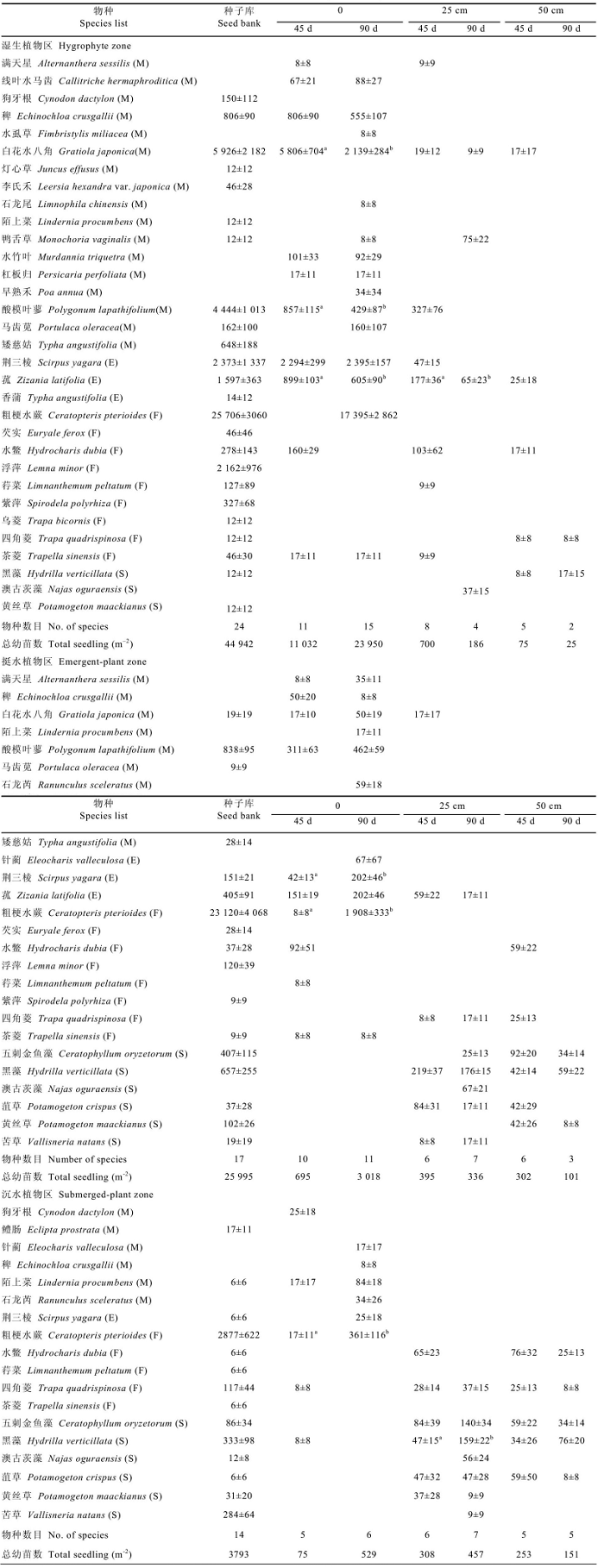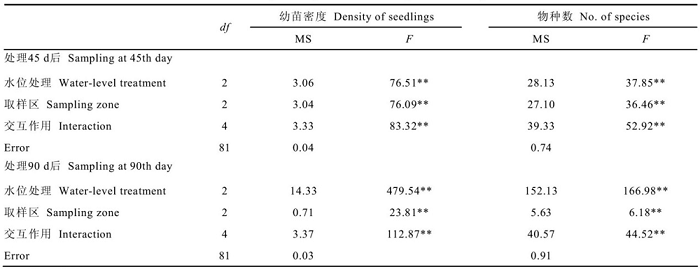

Chin J Plant Ecol ›› 2009, Vol. 33 ›› Issue (3): 546-554.DOI: 10.3773/j.issn.1005-264x.2009.03.013
• Research Articles • Previous Articles Next Articles
XU Yang1,2, LIU Wen-Zhi1, LIU Gui-Hua1,*( )
)
Received:2008-07-02
Accepted:2009-02-09
Online:2009-07-02
Published:2009-05-31
Contact:
LIU Gui-Hua
XU Yang, LIU Wen-Zhi, LIU Gui-Hua. PLANT DISTRIBUTION IN FRESHWATER LAKESHORE: RELATIVE IMPORTANCE OF SPECIES POOL LIMITATION VS. NICHE LIMITATION[J]. Chin J Plant Ecol, 2009, 33(3): 546-554.
 |
Table 1 Mean seed density of seed banks collected at three water level zones and germinated at 45 and 90 d under three water depth treatments (mean±SE)
 |

Fig.1 Composition of functional group of seed banks or seedlings germinating in three water depth treatments at 90th day from soils collected at three water level zones
 |
Table 2 Statistical results from the ANOVA testing the difference of water level treatment and sampling site in the number of seedlings and species at 45th day and 90th day
 |
| [1] |
Abernethy VJ, Willby NJ (1999). Changes along a disturbance gradient in the density and composition of propagule banks in floodplain aquatic habitats. Plant Ecology, 140,177-190.
DOI URL |
| [2] |
Boedeltje G, ter Heerdt GNJ, Bakker JP (2002). Applying the seedling-emergence method under waterlogged conditions to detect the seed bank of aquatic plants in submerged sediments. Aquatic Botany, 72,121-128.
DOI URL |
| [3] |
Casanova MT, Brock MA (2000). How do depth, duration and frequency of flooding influence the establishment of wetland plant communities? Plant Ecology, 147,237-250.
DOI URL |
| [4] |
Ehrlen J, Munzbergova Z, Diekmann M, Eriksson O (2006). Long-term assessment of seed limitation in plants:re-sults from an11-year experiment. Journal of Ecology, 94,1224-1232.
DOI URL |
| [5] |
Eriksson O, Ehrlen J (1992). Seed and microsite limitation of recruitment in plant populations. Oecologia, 91,360-364.
DOI PMID |
| [6] |
Foster BL, Tilman D (2003). Seed limitation and the regu-lation of community structure in oak savanna grass-land. Journal of Ecology, 91,999-1007.
DOI URL |
| [7] |
Galinato MI, van der Valk AG (1986). Seed germination traits of annual sand emergents recruited during draw-downs in the Delta Marsh, Manitoba, Canada. Aquatic Botany, 26,89-102.
DOI URL |
| [8] |
Grace JB (1989). Effects of water depth on Typha latifolia and Typha domingensis. American Journal of Botany, 76,762-768.
DOI URL |
| [9] |
Grime JP (1977). Evidence for the existence of three pri-mary strategies in plants and its relevance to ecological and evolutionary theory. American Naturalist, 111,1169-1194.
DOI URL |
| [10] | Grime JP (1988). The C-S-R model of primary plant strate-gies—Origins, implications and tests.In:Jain SK ed.Plant Evolutionary Biology. Chapman&Hall, London,371-393. |
| [11] |
Harwell MC, Havens KE (2003). Experimental studies on the recovery potential of submerged aquatic vegetation after flooding and dessication in a large subtropical lake. Aquatic Botany, 77,135-151.
DOI URL |
| [12] |
Keddy PA (1989). Effects of competition from shrubs onherbaceous wetland plants:a4-year field experiment Canadian Journal of Botany, 67,708-716.
DOI URL |
| [13] |
Keddy PA, Reznicek AA (1982). The role of seed banks in the persistence of Ontario’s coastal plain flora. American Journal of Botany, 69,13-22.
DOI URL |
| [14] |
Leck MA, Simpson RL (1994). Tidal freshwater wetland zonation:seed and seedling dynamics. Aquatic Botany, 47,61-75.
DOI URL |
| [15] | Liu GH, Li W, Li EH, Yuan LY, Davy AJ (2006a). Landscape-scale variation in seed banks of floodplain wetlands with contrasting hydrology in China. FreshwateBiology, 51,1862-1878. |
| [16] |
Liu GH, Li W, Zhou J, Liu WZ, Yang D, Davy AJ (2006b). How does the propagule bank contribute to cyclicvegetation change in a lakeshore marsh with seasonal drawdown? Aquatic Botany, 84,137-143.
DOI URL |
| [17] | Liu GH (刘贵华), Wang HY (王海洋), Zhou J (周进), Guo YH (郭友好) (2001). Spatial distribution and niche analysis of dominant species at the Oryza rufipogon Reserve in Chaling, Hunan. Acta Phytoecologica Sinica (植物生态学报), 25,65-70. (in Chinese with English abstract) |
| [18] |
Makana JR, Thomas SC (2004). Dispersal limits natural recruitment of African mahoganies. Oikos, 106,67-72.
DOI URL |
| [19] |
Maron JL, Gardner SN (2000). Consumer pressure, seed versus safe-site limitation, and plant population dy-namics. Oecologia, 124,260-269.
DOI PMID |
| [20] |
Pennings SC, Callaway RM (1992). Salt marsh plant zona-tion:the relative importance of competition and physical factors. Ecology, 73,681-690.
DOI URL |
| [21] | Pennings SC, Grant MB, Bertness MD (2005). Plant zona-tion in low-latitude salt marshes:disentangling theroles of flooding, salinity and competition. Journal ofEcology, 93,159-167. |
| [22] | Pennings SC, Moore DJ (2001). Zonation of shrubs in western Atlantic salt marshes. Oecologia, 126,87-594. |
| [23] |
Silvertown JW, Dodd ME, Gowing DJG, Mountford JO (1999). Hydrologically defined niches reveal a basis for species richness in plant communities. Nature, 400,61-63.
DOI URL |
| [24] |
Smith LM, Kadlec JA (1983). Seed banks and their role during drawdown of a North American marsh. Journal of Applied Ecology, 20,673-684.
DOI URL |
| [25] | Spence DHN (1982). The zonation of plants in freshwater lakes. Advances in Ecological Research, 12,37-125. |
| [26] | Thompson K (1978). The occurrence of buried viable seeds in relation to environmental gradients. Journal of Bi-ology, 5,425-430. |
| [27] |
Tilman D (1997). Community invasibility, recruitment limitation, and grassland biodiversity. Ecology, 78,81-92.
DOI URL |
| [28] |
van der Valk AG, Davis CB (1978). The role of seed banks in the vegetation dynamics of prairie glacial marshes. Ecology, 59,322-335.
DOI URL |
| [29] | Wang HY (王海洋), Chen JK (陈家宽), Zhou J (周进) (1999). Influence of water level gradient on plant growth, reproduction and biomass allocation of wet-land plant species. Acta Phytoecologica Sinica (植物生态学报), 23,269-274. (in Chinese with English ab-stract). |
| [30] |
Wilson SD, Keddy PA (1986a). Measuring diffuse competi-tion along an environmental gradient:results from a shoreline plant community. American Naturalist, 127,862-869.
DOI URL |
| [31] |
Wilson SD, Keddy PA (1986b). Species competitive ability and position along a natural stress/disturbance gradi-ent. Ecology, 67,1236-1242.
DOI URL |
| [32] |
Yuan LY, Liu GH, Li W, Li EH (2007). Seed bank variation along a water depth gradient in a subtropical lakeshore marsh, Longgan Lake, China. Plant Ecology, 189,127-137.
DOI URL |
| [33] |
Zobel K, Zobel M, Peet R (1993). Change in pattern diver-sity during secondary succession in Estonian forests. Journal of Vegetation Science, 4,489-498.
DOI URL |
| [34] |
Zobel M, Otsus M, Liira J, Moora M, Mols T (2000). Is small-scale species richness limited by seed availabil-ity or microsite availability? Ecology, 81,3274-3282.
DOI URL |
| [1] | RAN Song-Song, YU Zai-Peng, WAN Xiao-Hua, FU Yan-Rong, ZOU Bing-Zhang, WANG Si-Rong, HUANG Zhi-Qun. Effects of neighborhood tree species diversity on foliar nitrogen-phosphorus stoichiometry of Cunninghamia lanceolata [J]. Chin J Plant Ecol, 2023, 47(7): 932-942. |
| [2] | HU Zhao-Yi, CHEN Tian-Song, ZHAO Li, XU Pei-Xuan, WU Zheng-Jiang, DONG Li-Qin, ZHANG Kun. Effect of water level drop on nitrogen and phosphorus reabsorption of Carex muliensis in a herb swamp in Zoigê wetland, China [J]. Chin J Plant Ecol, 2023, 47(6): 847-855. |
| [3] | ZHU Wei, ZHOU Ou, SUN Yi-Ming, Gulimire YILIHAMU, WANG Ya-Fei, YANG Hong-Qing, JIA Li-Ming, XI Ben-Ye. Dynamic niche partitioning in root water uptake of Populus tomentosa and Robinia pseudoacacia in mixed forest [J]. Chin J Plant Ecol, 2023, 47(3): 389-403. |
| [4] | . Species delimitation and genetic conservation of the endangered firs Abies beshanzuensis and A. ziyuanensis#br# [J]. Chin J Plant Ecol, 2023, 47(12): 1629-1645. |
| [5] | LI Jie, HAO Min-Hui, FAN Chun-Yu, ZHANG Chun-Yu, ZHAO Xiu-Hai. Effect of tree species and functional diversity on ecosystem multifunctionality in temperate forests of northeast China [J]. Chin J Plant Ecol, 2023, 47(11): 1507-1522. |
| [6] | YE Jie-Hong, YU Cheng-Long, ZHUO Shao-Fei, CHEN Xin-Lan, YANG Ke-Ming, WEN Yin, LIU Hui. Correlations of photosynthetic heat tolerance with leaf morphology and temperature niche in Magnoliaceae [J]. Chin J Plant Ecol, 2023, 47(10): 1432-1440. |
| [7] | ZHANG Ling-Nian, ZHU Gui-Qing, YANG Kuan, LIU Xing-Yue, GONG He-De, ZHENG Li. Niche and interspecific association of main woody plants in Myrica nana shrubland in central Yunnan, China [J]. Chin J Plant Ecol, 2022, 46(11): 1400-1410. |
| [8] | WANG Chun-Cheng, ZHANG Yun-Ling, MA Song-Mei, HUANG Gang, ZHANG Dan, YAN Han. Phylogeny and species differentiation of four wild almond species of subgen. Amygdalus in China [J]. Chin J Plant Ecol, 2021, 45(9): 987-995. |
| [9] | LUO Ming-Mo, CHEN Yue, YANG Gang, HU Bin, LI Wei, CHEN Huai. Short-term response of soil prokaryotic community structure to water level restoration in degraded peatland of the Zoigê Plateau [J]. Chin J Plant Ecol, 2021, 45(5): 552-561. |
| [10] | YAN Han, ZHANG Yun-Ling, MA Song-Mei, WANG Chun-Cheng, ZHANG Dan. Suitable distribution simulation and local environmental adaptability differentiation of Lycium ruthenicum in Xinjiang, China [J]. Chin J Plant Ecol, 2021, 45(11): 1221-1230. |
| [11] | CHE Jian, ZHENG Jie, JIANG Ya, JIN Yi, YI Yin. Separation of phylogeny and ecological behaviors between evergreen and deciduous woody angiosperms in the subtropical forest dynamics plots of China [J]. Chin J Plant Ecol, 2020, 44(10): 1007-1014. |
| [12] | HU Wan,ZHANG Zhi-Yong,CHEN Lu-Dan,PENG Yan-Song,WANG Xu. Changes in potential geographical distribution of Tsoongiodendron odorum since the Last Glacial Maximum [J]. Chin J Plant Ecol, 2020, 44(1): 44-55. |
| [13] | SHI Jing-Jing,ZHAO Ming-Fei,WANG Yu-Hang,XUE Feng,KANG Mu-Yi,JIANG Yuan. Community assembly of herbaceous layer of the planted forests in the central Loess Plateau, China [J]. Chin J Plant Ecol, 2019, 43(9): 834-842. |
| [14] | WEN Chun, JIN Guang-Ze. Effects of functional diversity on productivity in a typical mixed broadleaved-Korean pine forest [J]. Chin J Plant Ecol, 2019, 43(2): 94-106. |
| [15] | LIU Jin-Liang, YU Ming-Jian. Community assembly processes in fragmented forests and its testing methods [J]. Chin J Plant Ecol, 2019, 43(11): 929-945. |
| Viewed | ||||||
|
Full text |
|
|||||
|
Abstract |
|
|||||
Copyright © 2022 Chinese Journal of Plant Ecology
Tel: 010-62836134, 62836138, E-mail: apes@ibcas.ac.cn, cjpe@ibcas.ac.cn